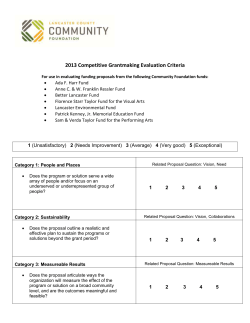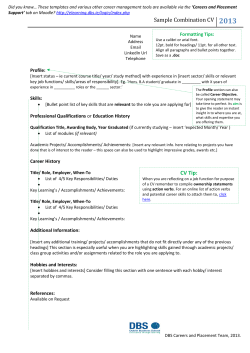
Writing an Excellent Project Plan Explaining your research to everyone
Writing an Excellent Project Plan Explaining your research to everyone Jerry Hatfield National Soil Tilth Laboratory SQRO (Ret.) Some Ground Rules • No question is too obvious…Ask! • Easiest way in a large group is to send a question (using the question box in the lower right corner). • We will read out questions received (only Mike sees them) without saying who they are from… • With this large group we’ll hold questions to the end. • DO NOT put your phone on HOLD for any reason. If you must leave use Mute (hold can create noise problems for the rest of us). • If you want to see a larger image use Full Screen Mode under the View tab at the top of your screen. (Esc returns you to the frames mode) What Causes the Problems • • • • Lack of clarity in project plan Lack of integration in the overall plan Lack of details in the experimental plan Lack of explanation of the role of project team members • Lack of explanation of the knowledge gaps and how project will fill them • Lack of confidence in the ability of the project team to accomplish the objectives Your Plan is a Marketing Tool …and the reviewers are your customers By page 5 reviewers should know: The subject of your research Why it is important What it will produce How you are going to get there The rest of the document will “flesh out” this but if the reviewers don’t know it by page 5, they probably won’t get it easily from the rest of the document. this means… • The project summary should present the overall thread of your work, the major gaps being addressed, how you will address them, and what you will produce…in no more than a dozen sentences. • The Objectives should be followed by one to two paragraphs that explain how they are integrated and how they address the overall goals of the work. A chart illustrating this and showing where individuals on the project team fit is most helpful. Where are the problems? (Science, Data, Writing) Science Missing Information Writing or Organization 3.00 Score/n 2.50 The problem is poor or inadequate writing! 2.00 1.50 Little difference 1.00 0.50 0.00 No Minor Moderate Major Not Rev ision Rev ision Rev ision Rev ision Feasible Action Class Don’t hide your details and expect the panel to guess your path! Comment Sampling “No Revision” …studies will fill rather substantial knowledge gaps. …well written and comprehensive …well written project plan …well organized, cogently prioritized and comprehensive research plan… Comment Sampling “Minor Revision” …studies will fill rather substantial knowledge gaps. …well written and comprehensive …well written project plan …well organized, cogently prioritized and comprehensive research plan… …well written, well organized, and easy to follow. Comment Sampling “Moderate Revision” …one of the better written …excellent discussion of technology …large research project plan but poorly organized. …concerns that some of the objectives can be completed by this team. …work and ability described as "adequate" …missing current information …hypotheses and plan well conceived, approaches appropriate Comment Sampling “Major Revision” …a heroic course that…will not achieve the stated objectives …serious flaws in experimental designs… General Lack of focus. Plan is so broad that it leaves out important details…not clear data will be relevant or interpretable. …lacks cohesion and clear direction …writing style, quality, and organization significantly detract… Short on details. Not well planned. Need to take process seriously. Comment Sampling “Not Feasible” …approaches highly flawed, lack detail, many experiments duplicative …poorly written…difficult to discern what the authors want to do. …proposed research contradicts intention of the proposal. …exaggerations, incomplete reviews…, and misleading comments, as well as poor grammar and organization. …lack of knowledge…incomplete understanding …fundamental misunderstanding… Work does not address stated objectives. Causes of Low Scores • Presentation of the information, not necessarily the scientific questions or the project team • Can not see the logical path of science toward the goal • Not an integrated plan but a collection of parts, plan looks and reads like it was assembled by a committee but not read for its “flow” once assembled. Attributes of a Good (Great) Plan • • • • Explains the problem, the current state of knowledge, your expertise in the problem area, your approach to solving the problem, and the products from the research program Convinces the review panel that you are the best team to conduct this research. Presents your plan as a narrative from front to back Showcases your ability as a project team to conduct this research and solve a problem These are not competitive grants but think about preparing this plan to demonstrate to NPS and AO that your funding for this effort is a great investment and the return you provide will benefit ARS and the American Public Document Outline Title and Investigator(s)………….page 1 Signature Page……………...........page 2 Table of Contents……….………….page 3 Project summary (250 words)...page 4 Objectives...…………..................page 5 Need for research (1-2 p) 15 - 30 pages Scientific Background (5-7 p) Prior Accomplishments (2 p) Approach & Procedures (6-15 p) Literature Cited Milestone Table (1-3 p) Past Accomplishments of Project Team Members Issues of Concern statements Appendices (letters plus other material) Project Summary • Marketing plan for your research plan that explains the research plan and its potential impact • Understandable by the non-technical reader Objectives • Don’t just state the objectives but explain the goals that are being addressed. • Link the objectives together by using a diagram that shows the project team and the products (A picture is worth a 1000 words). Need for Research & Scientific Background • Why is a solution to this problem important? • How does it fit into the NP action plan? • What are the current knowledge gaps? • What preliminary data exists from your program (graphs and tables help)? • This section doesn’t have to be long but set the stage for this research Need for Research & Scientific Background (Hints) • Your literature review doesn’t have to cover all of the information known on this topic. • Present related projects as more than a list from the CRIS search, show the linkages. • What the panel wants to see is what gaps exist in the current literature and how your project plan fills those gaps. • Most of the comments state that this is “great” literature review but it doesn’t tell us why the problem is important. Hypotheses • Clear, concise, and testable hypothesis statements. • Divide project plan into subobjectives each with testable hypothesis statements. • Question: Does your hypothesis statement relate to your experimental plan? Approach and Procedures • Adequate detail on experimental procedures • Data to be collected • Approach for the data analysis • Who is responsible for the conduct of the research? Approach and Procedures (Hints) • If you are using a new technique show that your project team has the expertise to use this method. • If you have a vacancy describe how this SY will fit into the project plan and if the objective is totally the responsibility of the vacant SY then give scope of what this SY will do and have a 6month milestone that their job will be to develop an experimental plan. Approach and Procedures (Hints) • Link the experiments back to the knowledge gaps and conclude by how these studies fill these gaps. • Lay the foundation for the research program by showing what you will be doing in the first set of experiments. • Link to the contingency section Contingencies • This is not the whining section! • Show how you will use the results from the initial studies to determine your next steps in the project plan. • If you are using a new technology, state how you will evaluate it’s effectiveness against other methods. Collaborations • Don’t merely list the collaborators but explain what they “bring” to the project plan. • Use the collaborator letters to provide evidence of their involvement. • If you have a SCA with a group provide a copy of the agreement in the appendix with a summary in the Collaboration section. Collaborations (Hints) • If there is a project within the location or area that is within the same NP show how these are linked or complement each other. • Don’t overstate collaborations for “window-dressing” but show viable collaborations. Project Management • How is the project team going to evaluate the progress of the project? • If you have collaborators how will the overall project team assess progress? Human & Physical Resources • Provide the confidence that you have the resources needed to conduct the research. – This is not the place to ask for more. • Human Resources – Vacancy- explain the vacancy and expected date it will be filled. – Training- explain any training needed on new methods and how this will be obtained (classes, time in other laboratories). • Physical Resources – Provide confidence that you have the resources required to answer the problems. Milestone Table • Use this table as a summary of your project. • Include the products and milestones that you expect to deliver over the life-cycle. • Remember these are only the starting points and will be changed each year through the life-cycle as the project progresses. Previous Accomplishments • Summary of each investigator in a related project objectives • Pertinent publications to the project objectives • Remember, the review team is probably aware of your research, but they still like to read about your assessment of your accomplishments. Supporting Materials • Letters from collaborators • Other material that helps support your ability to conduct the research Separating the Good from the Great • Prepare an integrated narrative that provides the detail and instills confidence about the project team approach to addressing the problem. • Shows that the project plan will fill important gaps needed for science and the National Program Action Plan. • Shows that outcomes will address problems. Hints • Read your plan with a fresh set of eyes after you have assembled the plan. • The plan should read as an integrated effort to solve a problem. • Use the plan as a reflection of the project teams ability to conduct problem-solving science. • Proofread your plan! Parting Thoughts • Don’t expect anyone else other than the Project Team to add quality to the project plan • Be proud of your research accomplishments and your approach to address this problem • Producing a quality plan takes time. Start early and seek the input of colleagues.
© Copyright 2025














